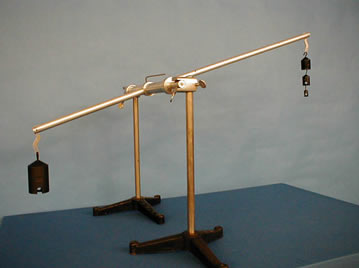Demos: 1J-17 Balance Arm

This apparatus, a rather massive aluminum arm designed so that a balance with variable lever arm lengths is possible, is intended to illustrate the necessity of including masses in calculations involving real devices. One can also determine the mass of the bar and the location of the center of gravity.
Directions: First, set up the balance arm so that 2/3 of it extends on one side and 1/3 extends on the other. The arm is exactly 1 m in length to facilitate this process. This can be done by unlocking the arm with the Allen wrench and sliding it in the sleeve. Now calculate how much mass is required on each side to have the system in balance. DO NOT INCLUDE THE MASS OF THE BAR AT THIS TIME. Of course, when the masses are chosen according to the standard torque equation the system is far from equilibrium because it was assumed that a massless arm was being used. This is visibly very obvious (watch out for crashing masses as they fall off the end).
After balancing the arm, the mass of the arm can be considered an unknown and can be determined from the torque equations.
Suggestions for Presentation: Ask the class what went wrong and hopefully get the response that assuming the mass of the balance arm was not important was incorrect. Now, repeat the calculation above except now include the mass of the balance arm (Marm = 0.785 kg) as an additional torque on the longer arm side and choose the masses accordingly. Now the system is in equilibrium.
Applications: None beyond torque demos
Last Updated: Nov 30, 2023 11:25 AM